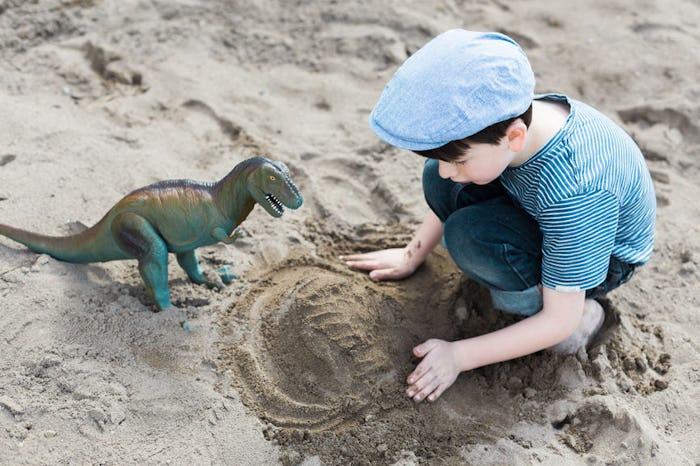Life

Experts *Really* Want Kids To Play In The Sand Bc Of These Surprising Benefits
I cannot think of a better way to spend a sunny summer day than by digging my toes into the sand and listening to the ocean waves crashing into the shore. Typically, I would enjoy this scene more without my kids nagging me for a snack every five minutes, but what's a mom to do? I try to make sure they have plenty of toys to keep them occupied while they play at the beach, and they usually have a blast building sand castles. In fact, playing with sand benefits kids in some impactful and surprising ways, experts say, and we should all be encouraging this type of sensory play.
When your kid plays in the sand, not only are they having fun, but they are doing some major developmental work. Erynn Weston, a Doctor of Physical Therapy currently working with Eternal Anchor, a program for children and adults with special needs in Baja California, explains that one major benefit is that playing in sand helps kids with fine motor skill development.
"Sand is great for tactile sensory play and reduces tactile defensiveness (which is when someone cannot handle certain sensations, especially getting dirty). Fine motor skills are also honed by playing with sand by grabbing, building, and tracing in sand," Weston says.
Just think of all of the squeezing and molding and packing kids have to do when they are building a sand castle. Each movement is helping them finesse their fine motor skills and keeping them occupied — sounds like a win-win to me.
In addition, kids also benefit from building in the sand with other kids, according to Justin Burton, M.D., chief of the Department of Physical Medicine and Rehabilitation at Children’s National Health System. "Digging in the sand and building a castle can help with strength and endurance. When these sometimes individual play activities become group activities, it adds the whole dimension of social and language development."
Laura Blair, a physical therapist assistant with Therapy 2000, explains how walking on sand can also help kids with coordination. "As a PTA, I think of the balance and stability the feet and ankle gain by walking or playing in the sand, especially barefoot! The foot takes in signals and works to adapt to maintain balance," she says.
I know some pretty rigorous adult workouts utilize walking or running on sand because of the resistance properties, so it's no wonder that the experts see benefits to playing in sand for kids in this manner as well. "Playing in sand is great for child development and coordination as the child motor plans obstacles and has to adapt to walking and running in the sand. Building obstacle courses or sand castles to jump over are fantastic for all kids as you can adapt size and level of difficulty for all ages," Blair says.
Another aspect of sand play that is beneficial to children outside of physical development sand play as a means of stress relief. Maureen Healy, author of The Emotionally Healthy Child and child development expert at Growinghappykids.com, says that sand play is often utilized in therapy for this reason.
"Children who play in the sand are alleviating their stress and frustrations. They found a constructive way to release their emotions, which as many of us know — oftentimes can go in any direction if not directed. Boys and girls who naturally enjoy the outdoors or like to touch things (sensory seeking) may particularly enjoy playing in the sand. Actually, the concept of playing in the sand as a therapeutic tool goes back many decades and therapists who are trained in this modality are called sandplay therapists," Healy says.
Dr. Burton also speaks to the way that sand play can have an impact on kids' emotions. "In reference to communication, children will often express themselves through play activities and sand play can be a way they express what they are feeling but may have difficulty saying," he says.
Some kids even do a fantastic job of treating the sand as their canvas. "Children who are able to direct themselves in 'free play' such as sand play are learning motor skills and hand-eye coordination, as well as developing their ability to trust their instincts and express their creativity, " says Healy. "Healthy child development encourages both right-brain play such as sand play, and also left-brain play such as puzzles and learning your alphabet," Healy says.
So go ahead and let your kids dig, scoop, pour, and run around in the sand to their heart's content. It really benefits them no matter which way you look at it.